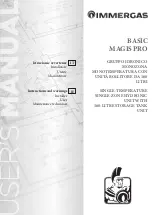
42
10. Flow Control Valve (Strongly Recommended)
The flow control valve prevents flow through
the system unless the circulator is operating.
Flow control valves are used to prevent gravity
circulation in circulator zone systems through zones
that are not calling for heat.
F. Water Quality and Treatments
1. The water directly in contact with the appliance
must meet the requirements in this section. Failure
to adhere to the water treatment requirements
in this manual can cause damage not covered
by warranty to the appliance, pumps, or other
components in the system.
2. The heat exchanger and other pipping components
will be subject to chemical effects when the
system is filled with water. The quality of water
used in the heating system is essential for the
successful operation and longevity of the product.
A successful water treatment plan will help to
maintain efficiency, reduce the frequency of repair
and/or replacement, and extend the working
life of the boiler and other system equipment. If
left untreated, poor water quality could cause a
number of problems including, but not limited to,
oxidation, scaling, corrosion, and fouling.
3. In order to develop an effective water treatment
plan, it will be necessary to gain knowledge of the
impurities dissolved in the water. Consult with a
qualified industrial water treatment professional to
establish a treatment plan. In addition, a periodic
testing/sampling plan should be developed.
4. To minimize corrosion and scale effects, adhere to
the water hardness levels specified in this section.
Refer to Table 21 and Table 22 for recommended
Corrosion/Scale inhibitors and treatment options.
a. The water must have a hardness greater than 3
gpg (grains per US gallon) and less than 9 gpg.
b. Water with a hardness of less than 80 ppm (5 gpg)
can have a pH level that is corrosive.
c. The pH of the water must be greater than 7.5 and
less than 9.5. If the system contains aluminum
parts, the pH must be less than 8.5.
5. Total Dissolved Solids (TDS) contribute to scale
buildup.
a. The combined TDS and water hardness cannot
exceed 450 ppm.
. Hydronic Piping
(continued)
NOTICE
NOTICE
The AMP heat exchanger is made from stainless
steel tubular double coil having relatively narrow
waterways. Once filled with water, it will be
subject to the effects of corrosion. Failure to take
the following precautions to minimize corrosion,
and overheating could result in severe product
damage.
Before connecting the appliance, insure the system
is free of impurities, grease, sediment, construction
dust, sand copper dust, and flux. Flush the system
thoroughly and repeatedly, if needed.
Iron oxide (red oxide sludge Fe2O3) is produced by
oxygenation. To minimize any oxygen presence in
the system, the system must be air free and leak
tight. Do not connect the boiler to radiant tubing
without an oxygen barrier. Using automatic water
refill is not recommended. However, if such refill
is employed, a water meter must be added to
evaluate the make up water volume taken after
initial fill and eliminate any water leakage as early
as possible.
Black oxide sludge (magnetite Fe3O4) forms as the
result of continuous electrolytic corrosion in any
system not protected by an inhibitor.
Scale deposit is made up of lime scale contained
in most distributed water and settles over the
warmest surfaces of the heat exchanger causing
subsequent overheating and eventual failure.
Scale can form from high water hardness and
slow water velocities. Failure to maintain the
recommended water hardness and flow rate
will result in a buildup of scale inside the heat
exchanger.
Refer to the service and maintenance section of
this manual for recommended heating system
water treatment products.
Содержание AMP 1000
Страница 13: ...13 IV AMP Component Identification continued Figure 3 Component Identification 26 25 22 18 2 23 27...
Страница 85: ...85 Notes...
Страница 86: ...86 This page is intentionally left blank...
















































